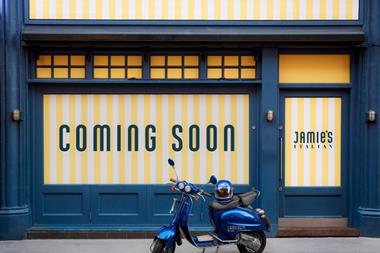The northern powerhouse is not only laying claim to the title of England’s second city, its inhabitants maintain it is catching up with London in terms of its restaurant scene, writes Stefan Chomka
It’s official, Manchester is the north’s second most ‘restauranty’ city, to use the parlance of the organisers of Northern Restaurant & Bar show. According to its statistics, the city is second only to Newcastle in its table of northern locations, with 1,576 residents per restaurant. Compare this with London’s restaurant density of 1,353 residents per restaurant and it’s clear that the recent talk about England’s second city being hot on the heels of the capital has foundation.
These statistics alone can’t be taken as a true barometer of the state of Manchester’s eating out scene but, added to a number of other factors, it’s evident that the city’s restaurant scene is in rude health. A number of well-respected operators, including Vapiano, Wahaca, Cabana, Red’s True Barbecue, Hawksmoor and Iberica have been attracted to the city in the past year or so and many more are on their way. Burgeoning ramen brand Shoryu has chosen Manchester to launch its first non-London site, as has Dishoom, and Casual Dining Group is set to launch its Belgian concept Belgo in the city later this year. Perhaps the clearest sign yet of the city’s untapped potential, is the news that Soho House is looking to open a private members’ club in Manchester. Nick Jones doesn’t do duff locations.
“Manchester is booming, its dining scene is booming,” says Thom Hetherington, managing director at Holden Media, which organises the Northern Restaurant & Bar show. “The number of restaurants in the city has risen by 57% over the past decade, and by only 32% in London, and the city’s restaurant density has increased faster than London over the past three years.”
Hetherington acknowledges that Manchester’s eating out scene has been prematurely heralded as being on the road to rivalling London, but believes the city can finally lay claim to being a true eating out destination thanks to how it has evolved over the past few decades. The city’s lack of a tube system has in the past led to an exodus of workers from the city centre, he says, making mid-week restaurant trade tricky but new, large-scale residential schemes in central areas have addressed this issue and helped changed the dynamic of the city.
“With no tube, a lot of people used to drive to work and that killed midweek trade. But over the past 20 years this has changed. In 1990 the city centre population was estimated to be only 500 people, and mostly in social housing, now there are more than 25,000 people living there. The population is also maturing and attracting affluent downsizers in their 50s and 60s. People don’t move into the city to stay in.”
With data from Deloitte Real Estate suggesting that 10,000 private-rented-sector flats are due to be built in the city in the next two years, Manchester’s city-centre restaurants will continue to benefit from a growing population. “Overall, Manchester has the fastest growing population outside of London,” adds Hetherington. “The residential map of the city will be totally redrawn in the next five years.”
Better value for money?
This influx of people and new brands into the city has inevitably led to rising costs, something Living Ventures managing director Paul Moran believes could have an impact on the restaurant sector. Rent increases and build costs – which he says have risen by up to 30% in recent years – will become more of an issue and will make it harder for some operators to succeed.
“The prices people are being forced, and are willing, to pay is a worry. When we first started out in the city we were getting reverse premiums and 18-months rent free. Today, people are asking for big premiums and charging £60 per sq ft. There is still a lot of development with residential areas in and around Manchester and so as long as people are not over stretching themselves they will be OK. But some people are going to over-leverage themselves because they will be worried that if they don’t get on board now they will miss the boat.”
Will Beckett, co-owner of Hawksmoor, which chose Manchester for its first non-London site last year, also expresses concern about rising rents. “Manchester is becoming the promised land for chains restaurants and it’s fantastic to see how well they are doing here. But one thing missing is boundary-pushing independent restaurants,” he says. “Levels of rent are making it less and less likely that we will see some.”
Indeed, Moran believes that, because of the rise in rents, Manchester is becoming comparatively poor value compared with London. “The per sq foot increase is much higher outside London. London is proving pretty good value at the moment.”
Ted Schama, director at Shelley Sandzer, on the other hand, disagrees. He acknowledges that property costs have gone up over the years but maintains this is happening in many popular cities, including Liverpool and Leeds. And while some landlords are charging £60 per sq ft, this is at the top of the market, he says, with sites in areas such as the Northern Quarter typically going for half that figure. “Prime areas will attract the highest rents, but the premiums are still substantially lower than London. I see London accelerating at a faster rate per sq ft than Manchester. Manchester is still better value on an overall cost basis.”
That said, he acknowledges that Manchester operators face certain issues that their London cousins might not, in particular decisions over site size. “Do you look at smaller premises to keep it cosier on a Monday and Tuesday night, because there are those peaks and troughs you don’t get in Soho or Covent Garden or other high-volume areas in London, or do you keep it large so when get to the weekend you can take the big cash? It’s a question I can’t answer.”
Like every city, location is also key. Schama recommends operators that rely heavily on volume of trade look at the Printworks development of the city, whereas the Corn Exchange is “a cute place to go if you’re a shopper offer”. More student orientated brands should look at the Northern Quarter while the Spinningfields area should also be on operators’ radars.
Differences in footfall
Variances in footfall and early-week trade between London and Manchester have made many wary of moving from the capital, but there are other differences between the habits of the two cities’ populace that need to be taken into consideration.
“Manchester is not a place that loves high-concept restaurants,” says Beckett. “You might be able to open a successful restaurant in Hackney serving highly specialist food, but in Manchester it’s unlikely to work.”
Differences in eating-out habits between London and Manchester diners should be taken into account when considering a move to the city. According to research conducted by Zonal Retail Data Systems, for example, diners in the north-west have a higher propensity to eat out in a restaurant at lunchtime than Londoners. “One of the reasons for this is possibly that the grab-and-go market in London is much more prominent than in Manchester,” says Zonal’s marketing director Clive Consterdine.
Another difference is that people in London are more willing to book ahead for a meal – 55% – compared with 33% of people in the north-west.
And another glaring difference between the two is the lack of a Michelin star in Manchester. This is something that Manchester should still care about, says Hetherington. “A Michelin star makes the city visible to a certain type for gastro tourist. We need that flow of tourism and the profile of a Michelin star would undoubtedly help.”
It’s on its way, believes Moran. “Fine dining is becoming more expansive in Manchester, with a lot of people talking about Michelin stars and it is something Manchester should aspire to. It will be achieved within the next year. Manchester is becoming a second city and will rival London on a much bigger basis. Being a Liverpudlian, that’s very hard for me to say.”









































